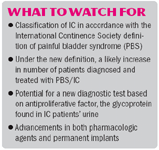Article
Progress continues on diagnosis, treatment of IC
More effective treatment will come as interstitial cystitis becomes better defined and research makes inroads on the epidemiology and etiology of this enigmatic and difficult-to-treat condition.

That is the prediction of Philip M. Hanno, MD, medical director of the department of clinical effectiveness and quality improvement at the University of Pennsylvania Health System and urologist at the Hospital of the University of Pennsylvania in Philadelphia. Urologists will be hearing about these developments and more at the AUA meeting in San Antonio.

That definition is "the complaint of suprapubic pain related to bladder filling usually accompanied by other symptoms, such as increased daytime and nighttime frequency in the absence of proven urinary infection or other obvious pathology." Whether IC is a subset of this defined by specific cystoscopic or histologic features remains to be seen. IC experts look forward to an NIDDK international conference in the next year or two to define the syndrome and settle the nomenclature.
Treating more patients Far from being a simple change in terminology, the redefinition of IC will broaden the population that fits the diagnosis, Dr. Hanno believes, bringing treatment to more patients who need it and also open doors for drug development.
Whatever definition clinicians on the front lines of diagnosis may be using, new research is showing that PBS/IC is much more common than previously thought. As part of the National Health and Nutrition Examination Survey (NHANES), patients were asked if they had had symptoms of a bladder infection that lasted more than 3 months and if they were also told by their doctor that they had IC or PBS. An analysis of those data by J. Quentin Clemens, MD, of Northwestern University and colleagues at Stanford University to be presented at the annual meeting, shows that the prevalence of PBS/IC is 1 in 120 women and 1 in 1,700 men.
These figures, of course, may be skewed by inaccurate recall and confusion with other forms of cystitis. Exciting news, said Dr. Hanno, is that in 5 years, we should have a firm number on prevalence. An epidemiologic study of PBS/IC that should definitively pin down its prevalence and bring clues to its cause is under way as an NIDDK-sponsored study run by Rand Corp.
The hoped-for future NIDDK conference related to nomenclature and redefinition may improve diagnosis and suggest a diagnostic and treatment algorithm. That same conference may also be able to suggest ways of subtyping the disease.
Diagnosis and treatment A new diagnostic test for IC could be the result of last year's major breakthrough-the characterization of antiproliferative factor (APF), the glycoprotein uniquely found in IC patients' urine. A commercial test for APF is still in the offing because more laboratories need to repeat the results.
Meanwhile, Susan Keay, MD, PhD, and her team at the University of Maryland, Baltimore, are homing in on the etiology of IC. In a study to be presented in San Antonio, the team discovered that APF inhibits tight-junction proteins and rapidly increases paracellular permeability. That may account for the "leakiness" of IC bladders, which has long been thought to contribute to IC symptoms by allowing irritating substances to leak into the bladder wall. In the future, speculated Dr. Hanno, this line of research could bring pharmacologic agents that block the pathway that leads to IC.
















